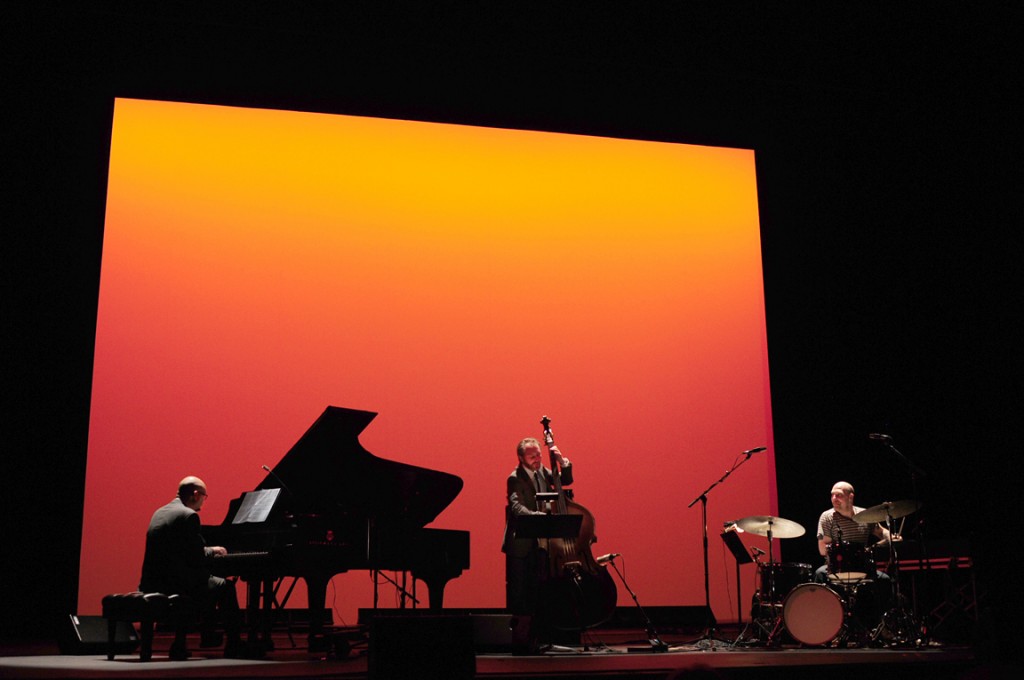Jazz Review: The Bad Plus Celebrates Igor Stravinsky’s “Rite of Spring”
Postmodern jazz trio The Bad Plus plays some of the prettiest Stravinsky ever performed.
By Steve Mossberg
The Bad Plus is one of the rare jazz groups of our time that manages to be artistically challenging while staying relevant and accessible. How magic is this combination of intelligence and popular appeal? It sold out two shows at Boston’s Institute of Contemporary Art on Friday night, where the musicians spent the majority of their time performing Igor Stravinsky’s 100-year-old, avant-garde ballet the Rite of Spring. The crowd was young for a jazz concert, very young for a classical concert—and the audience was clearly elated at what they saw and heard.
The trio of Ethan Iverson on piano, Reid Anderson on bass, and Dave King on drums first put together their version of the ballet for a 2011 commission at Duke University. When Stravinsky’s piece premiered in 1913, it caused riots in Paris, partially because of its tale of ritual sacrifice in a Russian steppe village, partially due to its innovative choreography and (then) off-putting costumes, and in no small part because of its incredibly aggressive, dissonant, and hard-to-follow modernist score. Today’s listeners are much more open to the music’s innovations, though when done with genuine conviction, Rite of Spring remains a challenge for musicians and audience alike.
The Rite of Spring is very difficult to interpret and perform. Most jazz groups opt for Stravinsky’s earlier, easier ballet The Firebird when paying tribute to the composer. The piece is filled with dense, dissonant textures, primal thumping rhythms, and complex rhythmic figures. The Bad Plus was up to the challenge on Friday, performing the piece flawlessly, with impressive classical refinement. Iverson juggled huge orchestral parts with only two hands. Anderson’s agile pizzicato caught every turn of Stravinsky’s original. King was given the most creative latitude (Stravinsky obviously didn’t score for drum set), and he provided percussive oomph, adding grooves to support the melodic instruments—all from memory.
The Bad Plus is known as the trio the makes jazz sound more accessible and contemporary to non-jazz audiences. The group is well known for their imaginative but faithful rock covers, where they add imaginative improvisation accents to, say a Nirvana song, without sacrificing any edge. One would assume that the approach of the trio when playing Stravinsky would be a postmodern, indie-rock reading, and indeed the opening of the piece, complete with sampled piano and Instagram-style shots of the sun, delivered just that kind of effect. Once the curtain opened, however, the group was all acoustic, very straightforward and very classical.
The most profound effect of playing Stravinsky’s infamously dense score with such sparse instrumentation and exacting performances was that it lent a fresh clarity to the piece. The absence of brash winds and aggressively bowed strings cleared the sonic dirt out of the noisy tone clusters of the original: the minimalism revealed the presence of some shockingly beautiful, Russian folk-influenced melodies. The Bad Plus plays some of the prettiest Stravinsky ever performed.
Although the classical piece sounded surprisingly unaffected in contemporary hands, the performance supplied a couple of incisive personal touches. The “Spring Rounds” section of the ballet’s first half has always come off as the grooviest part of the piece, and, despite its clear roots in the folk tradition, the music may reflect some of Stravinsky’s growing interest in jazz at the time. Dave King played a simmering, Elvin Jones-style rhythm in this section, and the group added a deep swing feel to the music.
The second half of the ballet, which deals explicitly with the sacrifice, was mostly untouched: it was accompanied by a very well done video of a dancer (in the original costume design) performing the fatal dance. During the final moments of Stravinsky’s score, where a flute/piccolo burst signifies that the sacrifice’s neck has been broken, the band chose to add another highly aggressive 30 seconds of heavily syncopated rock, accompanied by a blood red screen.
When The Bad Plus finished with the Russian master, the trio played what Reid Anderson described as a “triumphant victory lap” made up of some of the group’s original material from the last 10 or so years. First came the bassist’s “Giant,” which is a very sweet and breezy, mid-tempo pop ballad that starts out with a soulful bass cadenza.
Next up, the trio played two of the drummer’s originals, “The Empire Strikes Backwards” and “I Want to Feel Good, Part 2.” King is a musician of staggering technical ability, but as a composer, he generally chooses to play up his bright sense of humor and inventive curiosity. He made good use of a toy marching drum and his trademark Fischer-Price Happy Apple as well as his standard skins. Iverson showed, as he so often does, that he’s currently one of our top jazz pianists as he improvised engaging, cliché-free lines over very difficult rhythmic fields.
After closing its set with Anderson’s (almost) danceable “Never Stop,” the trio chose to play “Flim” by the legendary electronic composer Aphex Twin, as the encore. “Flim” has long been a staple for The Bad Plus, and it provides a poignant counterpoint to The Rite of Spring. The connection between a masterpiece from a classical visionary and the popular work of a dance music producer? The irreverent trio treated them both with the same respect, insight, exuberance, and down-to-earth smarts.
Tagged: Dave King, Ethan Iverson, Institute of Contemporary Art, Reid Anderson, The Bad Plus



Spot on review; I also appreciated the deep “swing” the Bad Plus heard under the familiar score.
BTW the dancer was Beatrice Rodriguez in the Joffrey Ballet reconstruction of whatever can still be known about Nijinsky’s original choreography by Millicent Hodgson. The Bad Plus team solarized and sampled an available dance video.
That’s not accurate– the video artists filmed a dancer from the Mark Morris Group performing the choreography.
Really? If so, I stand corrected!